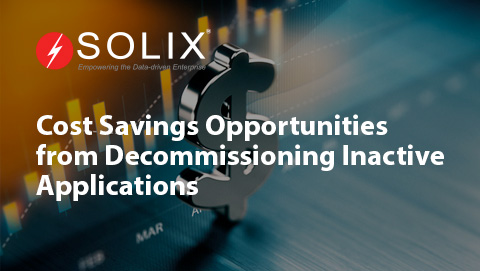
Application Retirement vs Other Understanding the Differences
When organizations reach a point where they need to streamline operations, one key question that often arises is what is the difference between application retirement and other IT strategies This question is crucial because your choice will significantly impact your business’s efficiency, cost, and future growth. Application retirement refers specifically to the process of phasing out old applications that are no longer essential, while other strategies might include application modernization, consolidation, or replacement. Understanding these differences can help drive informed decisions for your organization.
As a former project manager at a mid-sized firm, Ive had my fair share of decisions that revolve around application management. In one instance, we faced the challenge of outdated software that was not only costly to maintain but also fraught with security vulnerabilities. This is where the distinction between application retirement and other strategies became apparent. Retiring the application proved to be not just a cost-cutting measure, but also a means to enhance operational efficiency and safety.
What Is Application Retirement
Application retirement is the process of systematically decommissioning applications that no longer serve a purpose or that can be replaced with newer, more efficient software solutions. It involves several steps, including evaluating the applications importance, transferring required data, and ensuring compliance with regulations, especially in sectors like healthcare and finance. The goal is to free up resources and minimize maintenance costs while maintaining the integrity of organizational data.
This process is particularly vital because legacy applications often consume disproportionate amounts of IT resources. By transitioning away from these systems, organizations can allocate more time and budget to innovative projects. For example, in our earlier situation, when we decided to retire an outdated customer relationship management system, we saved substantial operational costs that we then reinvested into developing new digital solutions for better customer engagement. Such moves towards application retirement can significantly enhance a businesss agility in a competitive market.
Why Choose Application Retirement Over Other Strategies
While options like application modernization and consolidation are also valid, they might not always be the best solutions, especially for outdated systems that come with hefty maintenance costs. Lets unpack how application retirement compares with these alternatives.
Application modernization involves updating software to improve its functionality. This strategy can be tempting, as it allows businesses to retain familiar systems while enhancing capabilities. However, modernization often requires substantial investment in both time and resources. Moreover, if an application has reached a point of obsolescence, modernization may only create a temporary fix without tackling underlying inefficiencies.
On the other hand, application consolidation aims to combine multiple applications into fewer platforms to streamline operations. While this can make administration smoother, it may lead to unnecessary complexities if the applications in question are already outdated. Consolidating obsolete systems can further compound issues down the line, as any difficulties make their migration more challenging.
Considerations When Deciding on Application Retirement
Making the decision to retire an application isnt always straightforward. Organizations should consider several factors
1. Business Needs Is the application still aligned with current business objectives If not, it might be time to retire it.
2. Cost of Maintenance vs. Replacement Calculate ongoing maintenance costs and compare them against replacing or retiring the application altogether.
3. Security Risks Outdated applications are often more susceptible to security threats. Weigh these risks against potential data loss or migration issues.
After assessing these factors in our firms case, we recognized that the risks and costs associated with an outdated CRM were unsustainable. Transitioning to a more modern solution not only kept us secure but also improved our customer interactions.
How Solix Can Help with Application Retirement
One of the key considerations during the application retirement process is data management. You might wonder, what happens to the data within the retired systems This is precisely where solutions like Solix Enterprise Data Management come in. Implementing a robust data management solution can help ensure that all necessary information is preserved and transferred seamlessly, without compromising on compliance or operational integrity.
Solix offers tools that simplify the retirement process by automating data extraction, ensuring that critical information is not lost, and that it remains accessible for future needs. My experience with Solix solutions revealed that taking a comprehensive approach to data management both before and after application retirement can save time and resources while boosting overall confidence in the transition.
Lessons Learned from Application Retirement Experiences
Implementing application retirement can be a steep learning curve, but it also presents tremendous benefits. Here are some key takeaways from my experiences
1. Thorough Evaluation is Key Take the time to assess each applications performance and relevance carefully. A detailed analysis helps prevent premature retirement of critical systems.
2. Engage Stakeholders Early Involve various departments when contemplating which applications to retire. Their insights can uncover hidden dependencies and enhance the decision-making process.
3. Prioritize Data Management Ensure that you have a solid strategy for managing data. Proper software tools can help with this significantly, so consider leveraging established solutions like Solix.
As you ponder whether to pursue application retirement versus other strategies like modernization or consolidation these lessons can help guide your decisions toward maximizing value.
Wrap-Up
Deciding on application retirement versus other strategies is no small feat. However, by understanding the unique advantages of retirement and evaluating your organizational needs, you can make informed decisions that streamline operations and enhance your technology stack. If youre considering your next steps, I strongly encourage reaching out to Solix to discuss customized solutions that fit your specific requirements. They can help you navigate the complexities of data management and ensure a smoother transition.
For a consultation, dont hesitate to call Solix at 1.888.GO.SOLIX (1-888-467-6549) or reach out through their contact page
Author Bio Hi, Im Katie, and Ive spent years navigating the complexities of application management and retirement in various organizations. My insights into application retirement vs other strategies stem from real-world experiences, and Im passionate about sharing knowledge that helps companies transition to a more efficient software landscape.
Disclaimer The views expressed herein are my own and do not necessarily reflect the official position of Solix.
I hoped this helped you learn more about application retirement vs other. With this I hope i used research, analysis, and technical explanations to explain application retirement vs other. I hope my Personal insights on application retirement vs other, real-world applications of application retirement vs other, or hands-on knowledge from me help you in your understanding of application retirement vs other. Sign up now on the right for a chance to WIN $100 today! Our giveaway ends soon‚ dont miss out! Limited time offer! Enter on right to claim your $100 reward before its too late! My goal was to introduce you to ways of handling the questions around application retirement vs other. As you know its not an easy topic but we help fortune 500 companies and small businesses alike save money when it comes to application retirement vs other so please use the form above to reach out to us.
DISCLAIMER: THE CONTENT, VIEWS, AND OPINIONS EXPRESSED IN THIS BLOG ARE SOLELY THOSE OF THE AUTHOR(S) AND DO NOT REFLECT THE OFFICIAL POLICY OR POSITION OF SOLIX TECHNOLOGIES, INC., ITS AFFILIATES, OR PARTNERS. THIS BLOG IS OPERATED INDEPENDENTLY AND IS NOT REVIEWED OR ENDORSED BY SOLIX TECHNOLOGIES, INC. IN AN OFFICIAL CAPACITY. ALL THIRD-PARTY TRADEMARKS, LOGOS, AND COPYRIGHTED MATERIALS REFERENCED HEREIN ARE THE PROPERTY OF THEIR RESPECTIVE OWNERS. ANY USE IS STRICTLY FOR IDENTIFICATION, COMMENTARY, OR EDUCATIONAL PURPOSES UNDER THE DOCTRINE OF FAIR USE (U.S. COPYRIGHT ACT § 107 AND INTERNATIONAL EQUIVALENTS). NO SPONSORSHIP, ENDORSEMENT, OR AFFILIATION WITH SOLIX TECHNOLOGIES, INC. IS IMPLIED. CONTENT IS PROVIDED "AS-IS" WITHOUT WARRANTIES OF ACCURACY, COMPLETENESS, OR FITNESS FOR ANY PURPOSE. SOLIX TECHNOLOGIES, INC. DISCLAIMS ALL LIABILITY FOR ACTIONS TAKEN BASED ON THIS MATERIAL. READERS ASSUME FULL RESPONSIBILITY FOR THEIR USE OF THIS INFORMATION. SOLIX RESPECTS INTELLECTUAL PROPERTY RIGHTS. TO SUBMIT A DMCA TAKEDOWN REQUEST, EMAIL INFO@SOLIX.COM WITH: (1) IDENTIFICATION OF THE WORK, (2) THE INFRINGING MATERIAL’S URL, (3) YOUR CONTACT DETAILS, AND (4) A STATEMENT OF GOOD FAITH. VALID CLAIMS WILL RECEIVE PROMPT ATTENTION. BY ACCESSING THIS BLOG, YOU AGREE TO THIS DISCLAIMER AND OUR TERMS OF USE. THIS AGREEMENT IS GOVERNED BY THE LAWS OF CALIFORNIA.
-
-
-
White Paper
Cost Savings Opportunities from Decommissioning Inactive Applications
Download White Paper -




